
|
|||||||
| |||||||
MAP | GREEK VERSION | ONLY TEXT | CREDITS |
 |
COSTUMES FROM OTHER PARTS OF GREECE | |
|
ASIA MINOR: PONTOS The Pontian dress was an urban costume, in accordance with the eastern models which began life in the center of Hellenism at that time, Constantinople. This phenomenon was to be observed in most urban centers of the Ottoman Empire. Underneath the ladies wore a fine silk chemise, the bodice and sleeves of which were trimmed with crocheted lace, and then a pair of silk or satin breeches. Next came the well-known urban style kavadi, open at the front and with two side openings down to the hips. This garment was always lined and decorated round the hem with silk ribbon and delicate embroidery. Round the hips was wound a large silk scarf, trimmed with fringe of silk thread, folded into a triangle. With the birth of the first child, this scarf was replaced by one made of fine striped taffeta which was tied at the back, hanging down like an apron on the front. It was carefully ironed into ten-centimeter-wide horizontal creases. Silk jabots were positioned on the bodice, trimmed with white silk embroidery and crocheted lace or gold stitching. On top of this went a sleeved waistcoat, originally of black felt and later of dark-colored velvet decorated with silver stitches. From the wedding day onwards the bride wore a silk- covered disc decorated with a row of little coins that hung across the forehead. Dora Stratou Theater | |
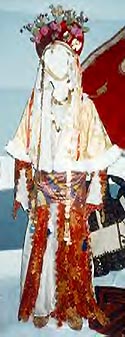
|
OLD ATHENS: THE BRIDAL COSTUME The girl's costume, particularly her festival one, is composed of pieces with a very old formal tradition. The matchmaking process began when the children were still very young. Care was taken to ensure that both children were in the same social class. During the engagement and right up to the wedding the young people never met; they did, however, exchange gifts. What the girl's dowry contained depended on her social class and wealth. When the time came, the bridal outfit was prepared. The bride's hair was washed with henna, then it was braided into small plaits (about 40). Gold and silk thread the color of the bride's hair was woven into it. Her female relatives helped the bride put on her very expensive bridal outfit. They put on the salivari, which was made of gold brocade and silk kamisi with lavish embroidery on the bodice and silk trim with sequins or pearls along the edges. Over this she put the kavadi, made of brocade and ornamented with braid and gold cord, done with consummate craft by tailors. The bride put on the anderi, for the first time. Worn by the richest ones, it was made out of heavy silk brocade, interwoven with gold or silver threads. Over the anderi the bride put around her waist a wide silk belt. A special headpiece, by the stolistra, had to be created for the occasion. First the stolistra put on the gilt, pasting on gold leaf to decorate nearly the entire face. In the middle of her forehead. she put a large gold star and above her eyebrows, following their line, she pasted a series of gold stars, made of gold leaf and bits of gold-bugs. The decorating jewelry belonged to the churches. The korona was fashioned of flexible laminate in the shape of a large crown; it appears that the empty spaces were closed on the inside with red velvet stuck on cardboard. they covered the velvet with coins, flowers, gold and silver. |
|
ATTICA, MESOGEIA: THE BRIDAL COSTUME One of the most opulent of Greek costumes is the bridal attire from the Mesogeia region of Attica. Apart from the foundi and the tzakos almost the entire outfit was a gift from the groom, together with the jewelry. It was worn only on high days and holidays during the year that followed the wedding day, or in rare cases until the woman reached the age of thirty. Thereafter a simpler dress without any embroidery was worn. The costume has a sleeveless chemise with embroidered hem, the foundi. A short-sleeved bodice, the tzakos, is worn over the chemise and a red belt around the waist. The costume includes two sleeveless gold-embroidered overdresses, the so-called griza me ta chrysa. The hair is adorned with peskoulia or masour plexides, i.e. cords with tassels and silver ornaments braided into the plaits. A small cap, the fesi, is entirely covered by a head-scarf of cloth-of-gold, the chrysi obolia. The costume is accompanied by a wealth of jewelry: the xelitsi, an ornament worn on the forehead, the large yiordani, a net-like pectoral ornament, another yiordani worn around the neck, and the kordoni, composed of usually ten chains hung with coins. The various traditional ornaments of the past have completely disappeared around the early 20th century.
Ioanna Papantoniou | |
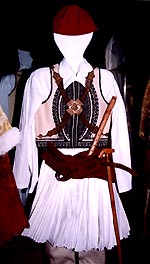
|
CENTRAL GREECE AND THE PELOPONNESE: THE TOWN COSTUME, FOUSTANELA The costume called Foustanela, established by Otto, the first King of Greece, as the formal court dress in the middle of the 19th century, prevailed in the urban centers of Moreas (Peloponnese) and Roumeli (Central Greece). This dress was originally the military outfit of the Greek chieftains. The costume was soon modified by the men for holidays and other festive occasions. The outfit that is shown here has two jackets, the inner waist coat, the yileki, and a second sleeved short jacket, the fenneli, with the sleeves falling freely over the back. The material that was used for this version. is wool. The embroidery is made of spun wool and the belt is of a fine leather work. The Foustanela has changed in the meaning of detailed work, the length of the fousta, and, sometimes, the number of jackets worn. The sleeves have become decorative, resembling wings without the function of sleeves. After all the changes, it has become the standard Pan-Hellenic male costume used to the modern times. |
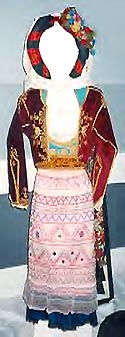
|
IONIAN ISLANDS: CORFU, LEFKIMMI Corfu (Kerkyra) is the northern-most of the Ionian Islands, the island of the Phaeacians. Although a half-way station between Italy and Greece, it was influenced by the village-style of costume of the neighboring mainland rather than the urban dress, as was the case with smaller centers in the rest of Greece. However, the headpiece shows some relationship with the headpieces of the Medieval age. The white chemise and the white petticoat serve as under-garments. The outer skirt was most of the time fashioned of taffeta. the front of the bust is covered by the boustina, a white embroidered dickey. The waist is girded by the chrysozonior chrysokimero, which was partly covered by a small sleeveless waistcoat, the tzipouni, held in place with false gold buttons. The bridal apron, the velenia, is made of either silk fabric or of tulle ornamented with multicolored trimmings. The costume includes a sleeved jacket, the peseli or kremezo. The ornate bridal head-dress, known as stolos or yadema, is largely based on the coiffure: the hair is arranged in a kind of crown, coiled around four tube- like hair-pads, which are wrapped in red ribbons.
Ioanna Papantoniou |
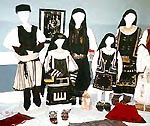
|
THACE, THESSALY, EPIRUS: THE SARAKATSANI NOMADS The Sarakatsani people are semi-nomadic stock farmers with true Greek origins, their roots lost deep within the bygone centuries. All expressions of their way of life are attached to very old traditions. Their flocks, their only possession and source of their sustenance, determine the unchangeable rhythm of their life revolving around the uninterrupted movement toward better pastures. the Sarakatsani of the Pindus range spread out in every direction, to the Adriatic and Ionian Seas, Macedonia and Thessaly, until eventually populating the plains of the whole of the Greek mainland, reaching Attica, Euboea and northern Peloponnese. In the final development of the costume, we notice two basic kinds. The first was worn by the Sarakatsani who were scattered over western Macedonia, Epirus, Thessaly, Sterea, as far as Attica and Euboea and the northern Peloponnese and is characterized by a frugal simplicity. The second kind was worn by the Sarakatsani who passed the winter in central and eastern Macedonia, the Serres and Kavala area, as well the mountainous region of Paranestion Rodopis. Benaki Museum |
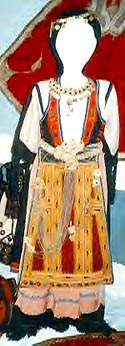
|
THESSALY: THE KARAGOUNIAN CUSTOME There has not yet been a definitive interpretation of the name "Karagounis". N.A. Veis writes it derives from kara ("black" in Turkish) and gouna ("coat") which, however, is not a part of their costume, while N. Eleftherides writes that it derives from karayiounan, a compound word from the Turkish kara and the Greek name Ionas, which in Persian becomes yiounan from Iaoun (Iaon, Ion) and is used generally to mean Greek. The bridal costume worn in the Thessalian plain is still used in our days in a modified and simplified version. It has a chemise, the linomaniko poukamiso, edged with a thick black fringe on the hem and sleeves. The diplos sayias consists of two cotton dresses. The outer dress, which is usually of indigo-blue color, has many folds and an added border sewn upon the hem, with embroidered patterns matching those of the short waistcoat, the yileki. The front of the bust is covered by a dickey of cotton material. The costume includes an apron of felt, and an apron made of silk. The kavadomanika, which are ornamental arm-bends, are worn over the sleeves. The head is dressed with false plaits and a cotton or silk kerchief. The costume is accompanied by a great many ornaments. The winter version of the costume has a heavy overcoat made of black wool.
Benaki Museum |